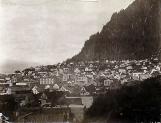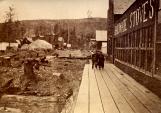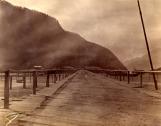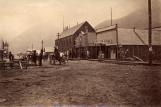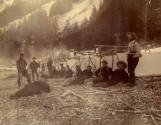16
There were two ways to get rich during the gold rush. One was to stake a good claim and mine a fortune. This was incredibly hard to do given that almost all the Klondike claims were already staked by the time the stampeders arrived in 1898. The other way to make a fortune was to 'mine the miners'. Some enterprising individuals and partners realized that selling provisions to the miners was the way to make money. You could only cross the White Pass if you had 2000 pounds of supplies. The Northwest Mounted Police were at the summit to check that everyone had enough food and equipment. If you needed anything you had to get it in Skagway on the way up. As a captive market, prices were set by the sellers.Additionally thousands of the stampeders who made it to Skagway, did not have enough money, supplies or heart to make it over one of the passes. These people sold all their goods and headed home. Local businesses made fortunes buying goods of those who turned back and selling them to the stampeders brave enough to carry on.
18
Map showing the areas in Alaska, British Columbia and the Yukon explored by the Mysterious 36.1898

21
Dawson seemed, and was, incredibly far away from the rest of the world's population centres. But with enough money, anything is possible. The lifestyle of the elite of Dawson in this period was quite sophisticated. Everything from designer ball gowns to fine wine and food made its way to Dawson by boat and trails. Cattle were shipped by boat to Pyramid Harbour , then were driven overland to Dawson22
Members of the Mysterious 36 at Skagway1898
Skagway
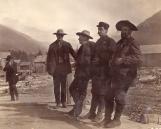 Credits:
Credits:(MacBride Museum Collection 1989.30.28)
23
Still clean, and largely clean-shaven, the group waited in Skagway while other stampeders disembarked and began climbing the Chilkoot or White Pass. Who were the 36? Why didn't they stop in Skagway and go the Klondike like other stampeders? Where were they headed?25
Pyramid Harbour from the hill1898
Pyramid Harbor
 Credits:
Credits:(MacBride Museum Collection 1989.30.199)
27
The 36 arrived in Pyramid Harbour in early spring. Setting up their military style camp, they prepared to hike up the Chilkat River valley. Why were they here instead of in the Klondike? Where exactly were the 36 going? Who was funding them? Did they have information about a strike that no one else had?The 36 were not nearly as unnoticed as they had hoped. Mysterious, perhaps but not unobserved:
“When I reached this place (Pyramid Harbour) I found that the stories of gold had leaked out, and already a well equipped party of more than 30 men had landed here. To be exact, there are 36 of them; and owing to the absolute secrecy which they maintain regarding their destination they are already known as the Mysterious 36," Arthur Thompson from Gold Seeking on the Dalton Trail.
